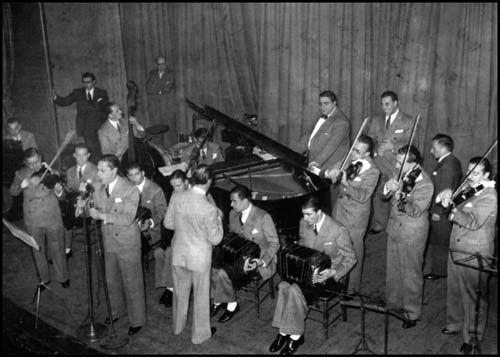The anatomy of a tango track
Most of the music we dance to in our lessons at Simply Tango was recorded during the ‘golden age’ of tango, which ran from roughly 1935 until 1955. To start with, you might find that all of the tracks sound quite similar, but as you listen more you’ll hear the great variety of harmonies, moods and arrangements in tango music.
Here’s an overview of the some of the key features to listen out for in the music, along with some examples from tracks you will have heard in our Cambridge beginner classes.
Four instruments
Tango orchestras can be quite large affairs but are made up of only four instruments. They always have a piano and at least one double bass, plus any number of violinists and bandoneon players. The bandoneon is a type of large accordion.
In Juan D’Arienzo’s tango orchestra from the 1930s (below) the bandoneon players are seated on the front row.

As you get used to listening to tango music you’ll notice different instruments coming to the fore throughout the tracks.
Un Tango y Nada Mas (A tango and nothing more) played by Alfredo de Angelis’ orchestra opens with a strong bandoneon section before the violins take over the melody at around the 34 second mark on this recording, followed by the piano at about 41 seconds.
A predictable beat
Even though there is no percussion in tango music, there is always a predictable beat, which makes it possible to dance to the music even if you don’t know the song well.
The time signature for tango tracks is 4/4, meaning 4 beats to the bar. For vals (waltz) tracks it’s ¾. Pobre Flor by Alfredo de Angelis is a fast vals that is often played at milongas (social dances).
Milonga tracks have a time signature of 2/4, meaning two beats to the bar. Have a listen to Milonga Sentimental by Francisco Canaro and you should find it easy to hear the two beats in every bar.
8 bar phrases
Being aware of musical phrasing helps you to form a mental landscape of the song and can remind you to inject a different flavour to your dance reflecting the changes in the energy of the music.
Tango tracks are structured around 8 bar phrases, meaning that at the start of each 8 bar phrase something different usually happens – perhaps the piano takes over the melody from the violins, or some singing starts.
Bahia Blanca by Carlos Di Sarli has a slow beat and we often play it in our beginner’s classes. The whole track is only 2:23 long and the first 8 bar phrase lasts until 0:34. You’ll notice that at this point the music feels like it comes to some sort of conclusion, as though it is taking a pause and is getting ready to start the next phrase. This is a nice place to pause in your dancing as well.
The next 8 bars repeats the melody of the first in a slightly different arrangement, coming to an end at roughly 1:08 on the recording. The track consists of three more 8-bar phrases: ending at 1:42, 2:16 and the end of the track.
A variacion
The last 8 or 16 bars of most tango tracks have a change in tone, known as the varacion, or variation. It’s characterised by the introduction of a counterpoint melody, usually by the bandoneons and adds extra energy to the track. Once you know what to listen out for, it’s a useful cue to help you know that the ending is about to arrive!
In this recording of Juan D’Arienzo’s 1938 track Pensalo bien, the variacion starts at 1:52 and lasts for 16 bars until the end of the song.
See you soon at a Simply Tango class in Cambridge.